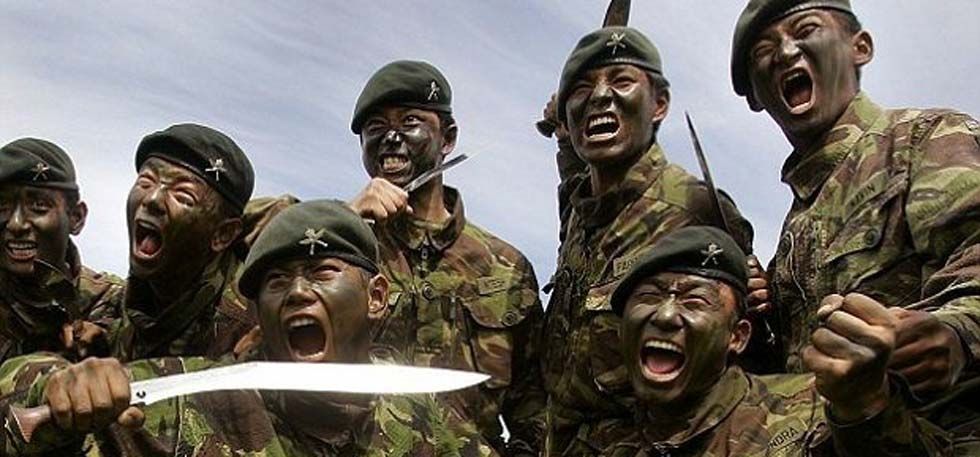If a person says he is not afraid of death, he is either lying or he is a Gorkha
These were the words of Field Marshal Sam Bahadur Manekshaw, in admiration of the fierce Gorkha regiment of the Indian Army.
But who are these brave soldiers? And how much do we know about their sacrifices for our motherland?
Let’s dive deep into the history and accomplishments of the Gorkha Regiments.
Brief History of Gorkha Regiment
Recruited from the Gorkha community of Nepal, the Gorkha soldiers have a long and illustrious history of military prowess. The Britishers first encountered the Gorkhas during the Anglo-Nepalese War. Gorkha was a feudal hill village in western Nepal. During the Anglo-Nepalese war, the Britishers encountered the mighty soldiers of this city and its king Prithwi Narayan Shah for the first time. And they were so impressed that they started recruiting Gorkhalis in their army.
The British raised the first Gorkha regiment – the Nasiri Battalion in 1815, that later adopted the title of the 1st King George V’s Own Gurkha Rifles (The Malaun Regiment). The British continued to recruit Gorkhas and raise new regiments, until 1947. After India gained independence in 1947, the existing Gorkha regiments were split between the British and Indian armies.
The Indian army raised the 1 Gorkha Rifle and the 3 Gorkha Rifles. In 1962, in the aftermath of the Chinese aggression, the 7th and 10th Gorkha Rifles and the 8th Gorkha Rifles were raised. Over the years, the Gorkha rifles have established themselves as some of the most fearless regiments of the Indian army, participating in all major wars and conflicts that India has been involved in.
Today, the Indian army has 11 Gorkha regiments consisting of around 35,000 soldiers. They have fought in all major wars and counter-insurgencies that India has participated in since independence. Be it the 1948 Indo-Pak war, the 1962 China war, the four wars against Pakistan, or counterterrorism operations in Jammu and Kashmir, the Gorkha soldiers have always upheld the highest traditions of bravery and sacrifice.
Identifying Gorkha Soldier
The Gorkha soldiers are characterized by their tilted hats and traditional Nepali kukris (knives) that they carry with themselves. Their war cry ‘Jai Mahakali, Ayo Gorkhali’ (Hail Goddess Mahakali, the Gorkhas are here) is known to strike terror in the hearts of their all enemies. Their loyalty, determination and fighting skills in high altitude and mountain terrain make them invaluable to the Indian army.
The Gorkha rifles have proven themselves as formidable fighters, upholding the highest traditions of courage and sacrifice. Their battle exploits are legendary and a source of pride and motivation for new soldiers. They remain an invaluable arm of the Indian army, protecting the nation’s freedom with unparalleled bravery and heroism. They have etched their names in golden letters through selfless and courageous service to the nation. They inspire valour and patriotism through their glorious history of battlefield heroics. The country is proud of its brave-hearted Gorkha regiments and their contribution to protecting India’s freedom and integrity.
Some Gorkha Battles & Gorkhalis that all Indians Must Know About
Battle of Naushera in Jammu and Kashmir in 1948
Major Kulbir Thapa of 2/1 Gorkha Rifles led his regiment to capture a crucial ridge from the enemy.
1962 War Against Chinese Aggression
1, 3 and 4 Gorkha Rifles were deployed in North-East India. Despite being outnumbered, they inflicted heavy casualties on the Chinese. Rifleman Ganju Lama of 1/1 Gorkha Rifles bravely took on Chinese troops and was awarded the Param Vir Chakra, India’s highest gallantry award.
Indo-Pak Wars of 1965 and 1971
Gorkha Regiments were deployed on both the Western and Eastern fronts and contributed to the victories in the war.
Kargil War, 1999
-
- Rifleman Sanjay Kumar displayed exceptional courage in climbing a steep snow-covered peak and neutralizing enemy bunkers. He was also awarded the Param Vir Chakra.
- Rifleman Thaman Bahadur Thapa of 1/2 Gorkha Rifles neutralized enemy bunkers at point-blank range and captured crucial peaks. He was posthumously awarded the Param Vir Chakra.
- Captain Manoj Kumar Pandey of 1/11 Gorkha Rifles led his men to recapture a crucial ridge from the enemy. Although wounded, he continued fighting and pushing the enemy back until he succumbed to his injuries. He was also awarded the Param Vir Chakra posthumously.
2009, Operations against Naxalites in Chhattisgarh
Major Mohit Sharma of 1 Gorkha Rifles sustained grievous injuries while trying to ambush insurgents. But he continued leading his men and eliminated the target, before succumbing to his injuries. He was awarded the Kirti Chakra posthumously.
2012, Operations in Jammu and Kashmir
Naik Chandrakant Rana and Naik Rajendra Rawat of 2/8 Gorkha Rifles neutralized 3 hardcore terrorists in a fierce close-quarter battle. Both were awarded the Kirti Chakra for their exemplary courage.
2015, Terror Attack in Punjab
Rifleman Jagdish Chand of 3/3 Gorkha Rifles sustained bullet injuries evacuating civilians. Despite being grievously injured, he continued fighting the terrorists until reinforcements arrived. He was awarded the Kirti Chakra for his exceptional bravery.
2016, Counter – Insurgency Operations in Jammu and Kashmir
Havildar Hangpan Dada of 35 Rashtriya Rifles fought terrorists and sacrificed his life saving his comrades. He was awarded the Ashoka Chakra, India’s highest peacetime gallantry award.
Apart from these, the Gorkha Regiments have been engaged in continuous counter-insurgency duties in the Northeast and Jammu and Kashmir for decades. And these are just a few tales of extraordinary courage displayed by Gorkha soldiers in recent times.
Their fearlessness and bravery continue to motivate their comrades and inspire young soldiers to follow in their footsteps.

